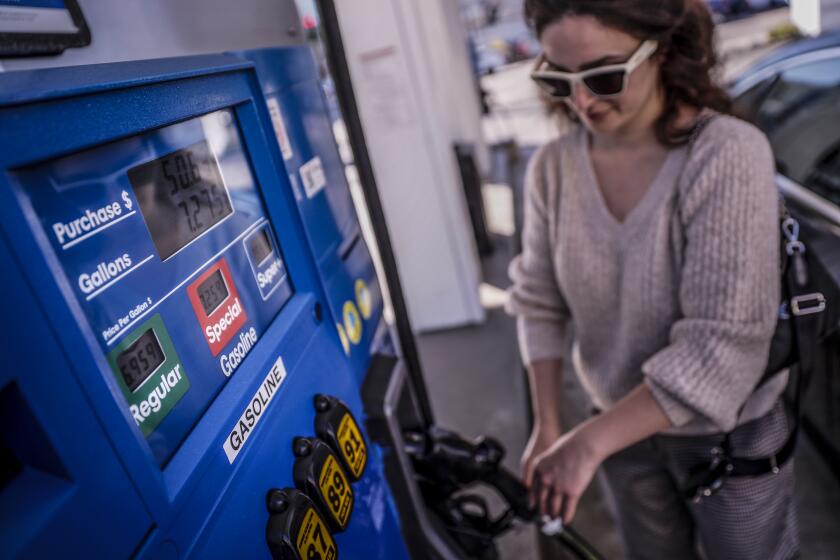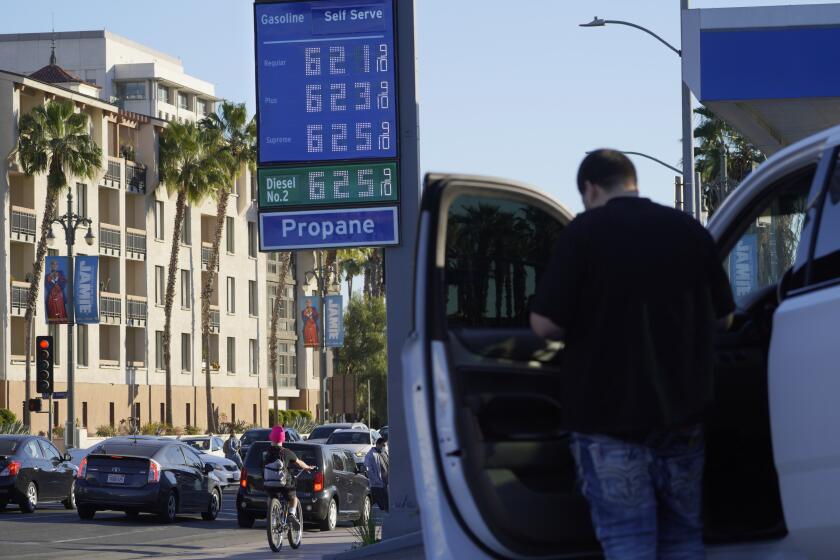California’s high gas prices have a little-known ingredient: Russian oil

- Share via
As gasoline prices surge to new heights after the U.S. banned Russian oil, California drivers are in a position to be uniquely squeezed at the fuel pump.
That’s because West Coast oil refineries are Russia’s best U.S. customers.
Russian oil is only a small piece of the U.S. energy picture, accounting for 3% of U.S. oil imports, and most of those imports flow to refineries on the West and East coasts. But nearly half of Russian oil shipped into the U.S. last year, or close to 100,000 barrels a day, ended up primarily in California, Washington and Hawaii, refinery consultant Andrew Lipow said.
And the amount of Russian oil imported into the West Coast has been on the rise, according to the U.S. Energy Information Administration, the Energy Department’s statistical arm.
Those refiners, led by Marathon and Chevron, already are replacing Russian oil with supplies from South America, northwest Europe and the Middle East, Lipow said. The new foreign oil will demand a higher price as the Russian oil ban further inflames energy markets.
“I know that California’s gasoline is so expensive compared to the rest of the nation,” said Lipow, a former oil trader who founded his eponymous Houston energy consultancy in 2004. “Unfortunately, I have bad news: The average there is going to go up by at least another 25 cents a gallon.”
California refiners used about 11.3 million barrels of Russian crude last year, followed closely by Washington at 10.4 million barrels. A large percentage of the gasoline refined in Washington is sold in California.
Q&A: How President Biden’s decision to halt U.S. purchases of Russian oil is likely to affect prices at the pump and beyond?
Californians already have been seeing records fall at the pump daily, although prices aren’t yet at an all-time high when adjusting for inflation.
California drivers paid an average of $5.444 a gallon Tuesday for regular grade, up a dime from the day before and up about 61 cents from a week earlier, according to the American Automobile Assn.’s daily fuel price tracker. The U.S. average hit a record $4.173 a gallon Tuesday, AAA data show, toppling a record that had stood since July 2008. (The 2008 price is about 20% higher than the current average after adjusting for inflation).
The auto club’s numbers update every day based on information collected by the Oil Price Information Service, which calculates the averages using pricing information from about 120,000 U.S. gas stations.
Oil and gasoline costs are increasing so quickly now that many service station owners are updating their prices more than once a day. Analysts are predicting that per-gallon average prices could hit $6 to $7 in California and some parts of the Northeast soon.
California motorists pay more than others because the state requires a unique blend of cleaner-burning fuel made by few refineries outside the Golden State. Higher taxes also contribute to Californians’ pain at the pump.
Plus demand is rising and the state’s gasoline stocks are at a 13-year low, California Energy Commission data show. And refiners are entering maintenance season as the state switches to summer gasoline, which is more costly and difficult to make.
The price of oil is the biggest component — 41%, the EIA says — of the price of gasoline. And soaring oil prices after Russia’s invasion of Ukraine have come directly out of drivers’ pockets.
Gasoline prices are still below their historical peak, adjusted for inflation, but no one can say how high they’ll go.
Although California is the nation’s seventh-largest crude oil producer, it is isolated from the bulk of U.S. oil production and so has become increasingly reliant on imports because of declining production from California and Alaska, Energy Department data show.
In addition, Asian refiners are competing for Alaskan and other sources of crude to replace Russian supplies.
Further complicating the supply outlook: California oil production is down 70% from the 1986 peak, Lipow said, and “the prospects for increased drilling in California are slim due to the regulations governing that activity.”
Oil sucked from the ground in Texas and the Midwest is piped primarily to the Gulf Coast, which accounts for 54% of the nation’s refinery capacity, Lipow said. Getting gasoline from that region to California requires a very expensive tanker trip on a U.S.-flagged ship, often through the Panama Canal.
Despite staggering price increases, there’s no evidence of physical oil or gas shortages yet, Chevron Chief Executive Mike Wirth said at an energy conference Monday, Bloomberg reported.
“We’ve got enough oil in the world, we’ve got enough gas in the world,” but “it’s not necessarily flowing on the routes it did before,” Wirth said before Tuesday’s Russian oil ban was announced. Wirth predicted that Russian oil probably would get to market through alternate routes.
More to Read
Inside the business of entertainment
The Wide Shot brings you news, analysis and insights on everything from streaming wars to production — and what it all means for the future.
You may occasionally receive promotional content from the Los Angeles Times.













